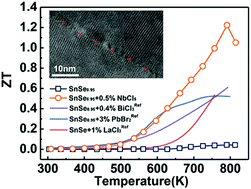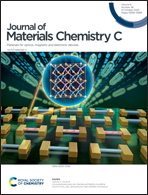Investigating the thermoelectric performance of n-type SnSe: the synergistic effect of NbCl5 doping and dislocation engineering†
Abstract
Tin selenide (SnSe) is a promising thermoelectric material because of its advantageous electronic structure and low thermal conductivity. In this work, n-type polycrystalline SnSe0.95 doped with a new dopant NbCl5 was prepared using vacuum melting and hot-pressing (HP) methods, which resulted in a textured microstructure and anisotropic thermoelectric performance. Several state-of-the-art characterization studies via XRD, SEM, and XPS were conducted to analyze the crystal phase, microstructure, and composition of the samples. The TEM observation showed that large amounts of dislocations and nanocrystalline grains existed in our polycrystalline SnSe0.95, which resulted in lower thermal conductivity and better mechanical performance compared to previous reports. The electrical transport measurements along the parallel and perpendicular directions to the HP pressure revealed that the scattering behavior of charge carriers was complex and had a profound effect on the overall thermoelectric properties. Finally, a maximum ZT value of 1.22 at 790 K was attained in the 0.5% NbCl5-doped SnSe0.95 sample, which exceeds most of the n-type polycrystalline SnSe systems doped with other halides.



 Please wait while we load your content...
Please wait while we load your content...